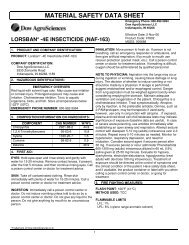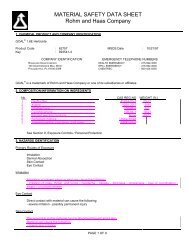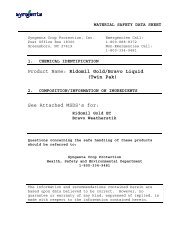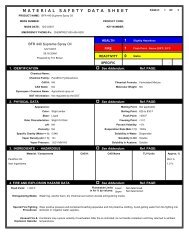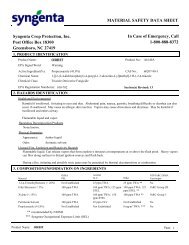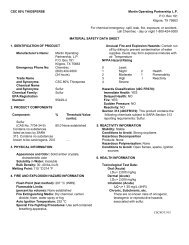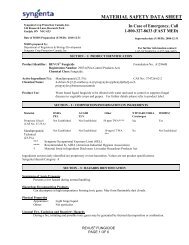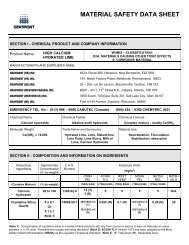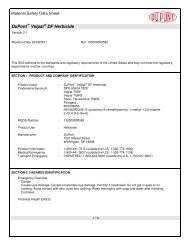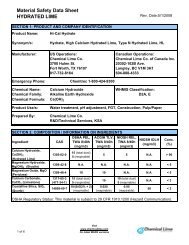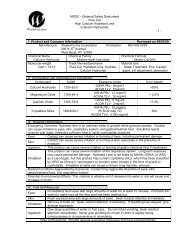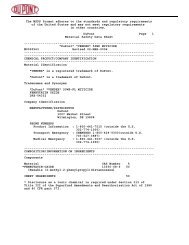MULTI-CHLOR
MULTI-CHLOR
MULTI-CHLOR
You also want an ePaper? Increase the reach of your titles
YUMPU automatically turns print PDFs into web optimized ePapers that Google loves.
<strong>MULTI</strong>-<strong>CHLOR</strong>12.5% Sodium HypochloriteEmergency 24 Hour Telephone: CHEMTREC 800.424.9300Corporate Headquarter:Hasa Inc.23119 Drayton StreetSaugus, California 91350Telephone 661.259.5848Fax 661.259.1538Material Safety Data Sheet<strong>MULTI</strong>-<strong>CHLOR</strong>Material Safety Data Sheet (MSDS No. 108)SECTION 1: CHEMICAL PRODUCT AND COMPANY IDENTIFICATION1.1 Product Identification:1.1.1 Product Name: <strong>MULTI</strong>-<strong>CHLOR</strong>1.1.2 CAS # (Chemical Abstracts 7681-52-9Service):1.1.3 RTECS (Registry of Toxic Effects NH3486300of Chemical Substances):1.1.4 EINECS (European Inventory of 231-668-3Existing Commercial Substances):1.1.5 EC Number: 231-668-31.1.6 Synonym: Bleach, Hypo, Hypochlorite, Liquid Chlorine Solution1.1.7 Chemical Name: Sodium Hypochlorite1.1.8 Chemical Formula: NaOCl1.2 Recommended Uses: Dairy, food and beverage industries: Sanitizingprocessing equipment.Water treatment: Sanitizing agent.1.3 Company Identification: Hasa Inc.23119 Drayton StreetSaugus, California 913501.4 Emergency Telephone Number: CHEMTREC1-800-424-9300 (24 hour)1.5 Non-Emergency Assistance: 661-259-5848(8 AM – 5 PM PST / PDT)Revision Date: 08/21/2011 (Supersedes previous revisions) Page 1 of 11
SECTION 2: EMERGENCY OVERVIEW and HAZARD IDENTIFICATION2.1 Emergency Overview. DANGER. CORROSIVE. Causes eye damage. Harmful ifswallowed or absorbed through skin. Do not get in eyes, on skin, oron clothing. Wear safety glasses or goggles or face shield,protective clothing, and rubber gloves when handling this product.Wash thoroughly with soap and water after handling and beforeeating, drinking, chewing gum, using tobacco, or using the toilet.Remove and wash contaminated clothing before reuse. Avoidbreathing vapors. Vacate poorly ventilated areas as soon aspossible. Do not return until strong odors have dissipated.2.2 Routes of Entry: Eyes, skin absorption, inhalation, ingestion.2.3 Short Term Exposure:2.3.1 Eyes: Causes serious eye irritation. Blurred vision. May causeimpairment of vision and corneal damage.2.3.2 Skin: May cause skin irritation and/or dermatitis. Prolonged skinexposure may cause destruction of the dermis with impairment ofthe skin to regenerate at site of contact.2.3.3 Inhalation: Accidental mixing with other chemicals or decomposition of sodiumhypochlorite vapor is irritating to the respiratory system.2.3.4 Ingestion: Ingestion of high concentrations may cause injuries togastrointestinal tract, liver, kidneys and central nervous system.Ingestion may cause gastrointestinal irritation, nausea, vomitingand diarrhea.2.3.5 Aggravated Asthma, heart disease, respiratory disorders.MedicalConditions:2.4 Long Term Exposure: Based on the toxicity profile and exposure scenarios for sodiumhypochlorite, EPA concludes that the risks from chronic and subchronicexposure to low levels of this pesticide are minimal andwithout consequence to human health.<strong>MULTI</strong>-<strong>CHLOR</strong>Material Safety Data Sheet (MSDS No. 108)SECTION 3: COMPOSITION INFORMATION ON INGREDIENTSIngredient Synonyms CAS No. Approx. Wt.%3.1 Sodium Hypochlorite Bleach 7681-52-9 12.5%3.2 Sodium Hydroxide Caustic Soda 1310-73-2 0.2%Revision Date: 08/21/2011 (Supersedes previous revisions) Page 2 of 11
SECTION 4: FIRST AID MEASURES4.1 IF IN EYES • Hold eye open and rinse slowly and gently with water for 15-20 minutes.• Remove contact lenses, if present, after the first 5 minutes, then continuerinsing eye.• Call a poison control center or doctor for treatment advice.4.2 IF ON SKIN ORCLOTHING• Take off contaminated clothing.• Rinse skin immediately with plenty of water for 15-20 minutes.• Call a poison control center or doctor for treatment advice.4.3 IF INHALED • Move person to fresh air.• If person is not breathing, call 911 or an ambulance, then give artificialrespiration, preferably mouth-to-mouth if possible.• Call a poison control center or doctor for further treatment advice.4.4 IF SWALLOWED • Call a poison control center or doctor immediately for treatment advice.• Have person sip a glass of water if able to swallow.• Do not induce vomiting unless told to do so by a poison control center ordoctor.• Do not give anything by mouth to an unconscious person.HOT LINE NUMBERHave the product container or label with you when calling a poison control center or doctor, orgoing for treatment. You may also contact 1-800-424-9300 for emergency medical treatmentinformation.NOTE TO PHYSICIANProbable mucosal damage may contraindicate the use of gastric lavage.<strong>MULTI</strong>-<strong>CHLOR</strong>Material Safety Data Sheet (MSDS No. 108)SECTION 5: FIRE FIGHTING MEASURES5.1 Flash Point: Not applicable.5.2 Flammability: Nonflammable and noncombustible.5.3 Auto-Ignition Temperature: Not applicable.5.4 Products of Combustion: Not pertinent.5.5 Fire Hazards: May decompose, generating irritating chlorine gas.5.6 Explosion Hazards: Not explosive.5.7 Fire Fighting Media and Instructions:5.7.1 Extinguishing Media: Use extinguishing measures appropriate to localcircumstances and the surrounding environment.5.7.2 Small Fires: Use carbon dioxide, or water spray.5.7.3 Large Fires: Use flooding quantities of water as fog.5.8 Special Remarks on Fire Hazards: Do not use Mono Ammonium Phosphate (MAP) fireextinguishers. Such use may cause explosion withrelease of toxic gases.Revision Date: 08/21/2011 (Supersedes previous revisions) Page 3 of 11
SECTION 6: ACCIDENTAL RELEASE MEASURES6.1 Small Spill: In case of spill, flood area where spill has occurred with large quantities ofwater. With permission from local authorities, diluted product may be flushed toa sanitary sewer. Product may also be absorbed with sand or diatomaceousearth. Absorbed products must be disposed of in accordance with applicableFederal, State, and/or local regulations. Contact Hasa Inc. for guidance.6.2 Large Spill: If possible without personal risk, stop leak. Try to prevent the materials fromentering drains, waterways, or sewers. Absorb with sand, diatomaceous earthor similar products and dispose of in accordance with local regulations. CallHasa Inc. for advice.SECTION 7: HANDLING AND STORAGE7.1 Handling: • Avoid contact with skin or eyes.• Do not ingest.• Avoid inhalation of vapor or mist.• Wear protective equipment if necessary.• Mix only with water in accordance with label directions.• Mixing this product with ammonia, acids, detergents, etc or with organicmaterials, e.g. feces, urine, etc. will release chlorine gas, which is irritating toeyes, lungs, and mucous membranes.7.2 HygieneMeasures:• Wash thoroughly with soap and water after handling and before eating,drinking, chewing gum, using tobacco, or using the toilet.• While handling this product, avoid eating, drinking or smoking.7.3 Storage: • Do not freeze.• Store in a cool, shaded outdoor area.• Inside storage should be in a cool, dry, well-ventilated area.• To maintain hypochlorite strength, do not store in direct or heated indoorareas.• Keep in original vented container.• Keep container closed when not in use.• Do not store adjacent to chemicals that may react if spillage occurs.• If closed containers become heated, vent to release decomposition products(mainly oxygen under normal decomposition).<strong>MULTI</strong>-<strong>CHLOR</strong>Material Safety Data Sheet (MSDS No. 108)Revision Date: 08/21/2011 (Supersedes previous revisions) Page 4 of 11
SECTION 8: EXPOSURE CONTROLS / PERSONAL PROTECTION8.1 Engineering Controls: Local exhaust ventilation to maintain levels belowSTEL (Short Term Exposure Limit) of 1 ppm aschlorine.8.2 Personal Protection:8.2.1 Eye / Face Protection: Wear safety glasses, goggles, or face shield toprevent eye contact.8.2.2 Skin Protection: Wear appropriate chemical resistant protectiveclothing and chemical resistant gloves to preventskin contact. Butyl rubber, Neoprene, or NitrileGloves should be worn when handling thismaterial. Wear chemical resistant clothing such asa rubber apron when splashing may occur. Rinseimmediately if skin is contaminated. Removecontaminated clothing promptly and wash beforereuse. Clean protective equipment before reuse.8.2.3 Respiratory Protection: Avoid breathing vapor or mist. When airborneexposure limits are exceeded (see below), useNIOSH approved respiratory protection equipmentappropriate to the material and/or its components.Full facepiece equipment is recommended and, ifused, replaces need for face shield and chemicalgoggles. For emergency and other conditionswhere exposure limit may be significantlyexceeded, use an approved full face positivepressure,self-contained breathing apparatus.8.2.4 Other Safety Equipment: Eye wash facility and emergency shower shouldbe in close proximity.8.3 Exposure Limits: Sodium Hypochlorite Chlorine*<strong>MULTI</strong>-<strong>CHLOR</strong>Material Safety Data Sheet (MSDS No. 108)8.3.1 AIHA (American Industrial HygieneAssociation) / WEEL (WorkplaceEnvironmental Exposure Levelguides) 20108.3.2 ACGIH (American Conference ofGovernmental Industrial Hygienists)TWA (Time Weighted Average)8.3.3 ACGIH STEL (Short Term ExposureLimit)8.3.4 OSHA PEL (Permisible ExposureLimit)2 mg/m 3 : 15 minute.(Short-term time weightedaverage)Not established.Not established.Not established.Not established0.5 ppm1 ppm0.5 ppm8.3.5 ACGIH Ceiling Not established. Not established8.3.6 NIOSH (National Institute forOccupational Safety & Health) IDLH(Immediate Danger to Life & Health)Not established.10 ppm8.3.7 OSHA STEL (Short Term Exposure Not established. 1 ppm as Cl 2Limit)8.3.8 NIOSH (15 min. ceiling) Not established. 0.5 ppm* Chlorine is unlikely to be present as a decomposition product, but may be present inincidents of accidental mixing with other chemicals.Revision Date: 08/21/2011 (Supersedes previous revisions) Page 5 of 11
SECTION 9: PHYSICAL AND CHEMICAL PROPERTIES9.1 Physical State and Liquid with pale yellow color.Appearance:9.2 Odor: Bleach9.3 Odor Threshold: Not applicable.9.4 pH (1% solution): 11.2 – 11.49.5 Boiling Point: Not applicable. Decomposes @ 110°C (230°F)9.6 Melting Point: Not applicable.9.7 Freezing Point: -23.3°C (-10°F)9.8 Evaporation Rate (BuAc=1): Not available.9.9 Flammable Limits: Not applicable.9.10 Vapor Pressure: 12.1 mm Hg @ 20°C (68°F)9.11 Vapor Density: (Air=1) 2.619.12 Relative Density or 1.2 g/mL or 10 lb/gallon @ 20°C (68°F)Specific Gravity (H 2 O=1):9.13 Solubility in Water: Mixes infinitely with water.9.14 Partition Coefficient: n- Not applicable.octanol / water:9.15 Viscosity: 1.75 - 2.50 centipoises (varies with temperature)9.16 Volatility: Not applicable.9.17 Molecular Weight: 74.5 g/mole9.18 Water / Oil Distribution Not applicable.Coefficient:9.19 Dispersion Properties: Not applicable.<strong>MULTI</strong>-<strong>CHLOR</strong>Material Safety Data Sheet (MSDS No. 108)SECTION 10: STABILITY AND REACTIVITY10.1 Stability: Stable under normal conditions of storage, handling, and use.10.2 Instability / Decomposition All bleach decomposition is dependant on temperature. ForTemperature:any given temperature, the higher the strength, the faster itdecomposes. In summary, for every 10 o C increase in storagetemperature, the sodium hypo-chlorite will decompose at anincreased rate factor of approximately 3.5.10.3 Conditions of Instability: High heat, ultraviolet light.10.4 Incompatibility with Oxidizing agents, acids, nitrogen containing organics, metals,Various Substances: iron, copper, nickel, cobalt, organic materials, and ammonia.10.5 Corrosivity: Corrosive to eyes and skin.10.6 Special Remarks on Rate of decomposition increases with heat.Reactivity:May develop chlorine if mixed with acidic solutions.10.7 Special Remarks on None.Corrosivity:10.8 Hazardous Polymerization: Will not occur.Revision Date: 08/21/2011 (Supersedes previous revisions) Page 6 of 11
SECTION 11: TOXICOLOGICAL INFORMATION11.1 Routes of Entry: Eyes, skin, ingestion, dermal absorption.11.2 Acute Toxicity:11.2.1 Oral Toxicity (LD 50 ): 3-5 g/kg (rat)11.2.2 Dermal Toxicity (LD 50 ): >10 g/kg (rabbit)11.2.3 Primary Eye Irritation: Corrosive11.2.4 Primary Skin Irritation: Corrosive11.2.5 Acute Inhalation No data available.Toxicity (LC 50 )11.3 Chronic Effects (Human RiskAssessment):Based on the toxicity profile and exposure scenarios forsodium hypochlorite, EPA concludes that the risks fromchronic and subchronic exposure to low levels of thesepesticides are minimal and without consequence tohuman health.11.4 Tolerance Requirement: Exempt (EPA document “Index to Pesticide ChemicalNames, Part 180 Tolerance Information, and Food andFeed Commodities (by Commodity)” July 2010<strong>MULTI</strong>-<strong>CHLOR</strong>Material Safety Data Sheet (MSDS No. 108)Revision Date: 08/21/2011 (Supersedes previous revisions) Page 7 of 11
SECTION 15: REGULATORY INFORMATION15.1 U.S. Regulations:15.1.1 OSHA HAZCOM (HazardCommunication)15.1.2 OSHA PSM (Process SafetyManagement)15.1.3 EPA FIFRA (Federal Insecticide,Fungicide and Rodenticide Act)15.1.4 EPA TSCA (Toxic SubstanceControl Act)15.1.5 EPA CERCLA (ComprehensiveEnvironmental Response,Compensation, and Liability Act)15.1.6 EPA RMP (Risk ManagementThis material is considered hazardous under theHAZCOM Standard (29 CFR 1910.1200)Not regulated under PSM Standard (29 CFR 1910.119)EPA Reg. No. :10897-26(Registered pesticide under 40 CFR 152.10)All components are listed or exempted.TSCA 12(b): This product is not subject to exportnotification.Reportable Quantity (RQ): 45.4 kg (100 lbs) or 80 gallons(based on 12.5% active ingredient).Not listed. (40 CFR 68.130)Plan)15.2 State of California Regulations:15.2.1 Safe Drinking Water and Toxic Enforcement Act of 1986 [Proposition 65,California only]: Small quantities – less than 100 ppm (parts per million) – of impurities,including bromates, may be found in all chlorinating products, including this product.Bromates are derived from bromides, which are present in sodium chloride (table salt) fromwhich chlorine is manufactured. Additional small quantities of bromates may be generatedduring the disinfection process. Bromates are known by the State of California to causecancer when administered by the oral (drinking or ingesting) route. Read and follow labeldirections and use care when handling or using this product. The US EnvironmentalProtection Agency has established a maximum contaminant level (MCL) for bromates indrinking water at 10 ppb (parts per billion). Application of this product in accordance with labeldirections at use dilution will not exceed this level.This warning is provided pursuant to Proposition 65, Chapter 6.6 of the California Health andSafety Code, which requires the Governor of California to publish a list of chemicals “known tothe state to cause cancer or reproductive toxicity.” This list is compiled in accordance with theprocedures established under the proposition, and can be obtained on the internet fromCalifornia’s Office of Environmental Health Hazard Assessment at http://www.oehha.ca.gov.15.2.2 CDPR (California Department of Pesticide Regulation) Registration No: 10897-26-AA15.2.3 CalARP (California Accidental Release Prevention Not regulated.Program)15.3 Canada Regulations:15.3.1 WHMIS (Workplace Hazardous • Classification: E (Corrosive Materials)Materials Information System) • Health Effects Criteria Met by this Chemical: E - Corrosive to skin E - TDG class 8 - corrosive substance• Ingredient Disclosure List: Included for disclosure at1% or greater.15.3.2 DSL (Domestic Substances List) All components of this product are on the DSL.15.4 International Inventory:15.4.1 AICS (Australian Inventory of Chemical On inventory or in compliance with inventory.Substances)15.4.2 KECI (Korean Existing Chemicals Inventory) On inventory or in compliance with inventory.15.4.3 PICCS (Philippine Inventory of Chemicalsand Chemical Substances)15.4.4 IECSC (Inventory of Existing ChemicalSubstances in China)15.4.5 NZIoC (New Zealand Inventory ofChemicals)On inventory or in compliance with inventory.On inventory or in compliance with inventory.On inventory or in compliance with inventory.<strong>MULTI</strong>-<strong>CHLOR</strong>Material Safety Data Sheet (MSDS No. 108)Revision Date: 08/21/2011 (Supersedes previous revisions) Page 10 of 11
SECTION 16: OTHER INFORMATION16.1 HMIS III (Hazardous Materials Identification System):16.1.1 HEALTH 216.1.2 FLAMMABILITY 016.1.3 PHYSICAL HAZARD 116.1.4 PERSONAL PROTECTION See Section 8.16.2 NFPA 704 (National Fire Protection Association):16.2.1 HEALTH 216.2.2 FLAMMABILITY 016.2.3 INSTABILITY 016.2.4 SPECIAL None16.3 International Fire Code / International Irritant.Building Code:16.4 ANSI (American National Standards Institute):16.4.1 Hazardous Industrial Chemicals - Complies with ANSI Z400.1 – 2004.MSDS-Preparation:16.4.2 Hazardous Industrial Chemicals - Complies with ANSI Z129.1 – 2006.Precautionary Labeling:16.5 GHS (Globally Harmonized System):16.5.1 Classification: Skin Corrosion / Irritation (Category 1).Serious Eye damage / Eye Irritation(Category 1)16.5.2 Symbol:<strong>MULTI</strong>-<strong>CHLOR</strong>Material Safety Data Sheet (MSDS No. 108)16.5.3 Signal Word: Danger.16.5.4 Hazard Statement: Causes severe skin burns and eye damage.Note: The information contained herein, while not guaranteed, was prepared by competenttechnical personnel and is true and accurate to the best of our knowledge and belief. NOWARRANTY OR GUARANTEE, express or implied, is made regarding the product performance,product stability, or as to any other condition of use, handling, transportation, and storage.Customer use, handling, transportation, and storage may involve additional safety and/orperformance considerations. Our technical personnel will be happy to respond to questionsregarding safe handling, storage, transportation, and use procedures. The safe handling, storage,transportation, and use procedures remain the sole responsibility of the customer. No suggestionsfor handling, storage, transportation, or use are intended as or to be construed asrecommendations which may infringe on any existing patents or violate any Federal, State, and/orlocal law and/or regulation, ordinance, standard, etc. This Material Data Safety Sheet has beenprepared by HASA, Inc. staff from test reports and other information available in the public domain.Revision Date: 08/21/2011 (Supersedes previous revisions) Page 11 of 11



